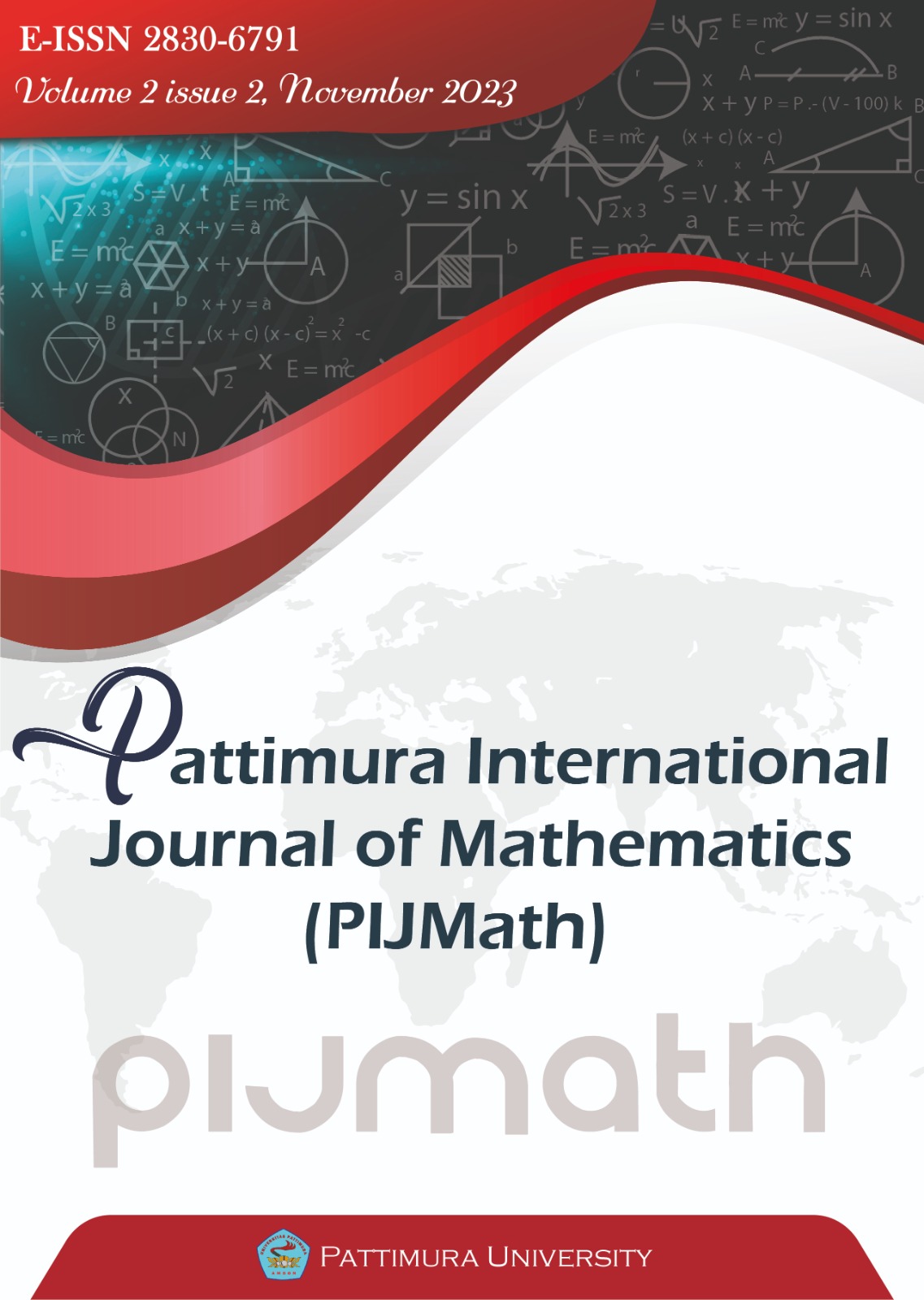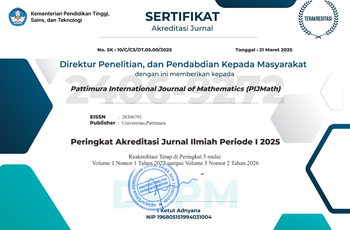Negative Binomial Regression in Overcoming Overdispersion in Extreme Poverty Data in Indonesia
Abstract
Indonesia's extreme poverty status in 2021 was recorded to be high at 4% or 10.86 million people. One of the efforts in poverty alleviation is to analyze the factors influencing extreme poverty. Although the number of studies on poverty in Indonesia continues to grow, the findings are inconclusive because they are often discussed qualitatively. This study aimed to analyze the factors that influence extreme poverty in Indonesia using negative binomial regression. The data used was the amount of extreme poverty in 34 provinces of Indonesia as the response variable. Then, the explanatory variables used consist of 8 from the Central Bureau of Statistics. The analysis stage sought data exploration, the correlation between variables, Poisson regression model specification and assumption test, handling overdispersion with negative binomial regression, and model feasibility test. Based on the AIC value and dispersion ratio, the negative binomial model obtained an AIC value of 920.03 with a dispersion ratio 1.372. It shows that the negative binomial regression model is good enough to model extreme poverty in Indonesia. Furthermore, the factors significantly influencing extreme poverty in Indonesia are households with proper drinking water, housing status, and families with access to appropriate sanitation.
Downloads
References
www.worldbank.org, “Ending Ekstrem Poverty,” www.worldbank.org, Jun. 2016. https://www.worldbank.org /en/news/feature/2016/06/08/ending-extreme-poverty (accessed Sep. 26, 2022).
Badan Pusat Statistik, “Berita Resmi Statistik Profil Kemiskinan di Indonesia Maret 2021,” Jul. 2021.
BPS, “Persentase Penduduk Miskin Maret 2020 naik menjadi 9,78 persen,” Badan Pusat Statistik, Jul. 15, 2020.
E. Sutrisno, “Mempercepat Pemberantasan Kemiskinan Ekstrem di Indonesia,” Indonesia.go.id, Jun. 18, 2022. https://indonesia.go.id/kategori/editorial/5074/mempercepat-pemberantasan-kemiskinan-ekstrem-di-indonesia? (accessed Aug. 18, 2022).
Biro Pers Media dan Informasi Sekretariat Presiden, “Rapat Terbatas Mengenai Strategi Percepatan Pengentasan Kemiskinan,” Kementerian Sekretariat Negara, Mar. 04, 2020. https://www.presidenri.go.id/transkrip/rapat-terbatas-mengenai-strategi-percepatan-pengentasan-kemiskinan/ (accessed Aug. 21, 2022).
www.bps.go.id, “Badan Pusat Statistik,” 2021. https://www.bps.go.id/ (accessed Sep. 24, 2022).
D. V. Ferezagia, “Analisis Tingkat Kemiskinan di Indonesia,” 2018.
Y. C. Pratama, “Analisis Faktor - Faktor yang Mempengaruhi Kemiskinan di Indonesia,” 2014.
D. Handayani, W. Safitri, and A. F. Artari, “Modeling Poverty Rates with Generalized Poisson Regression,” in AIP Conference Proceedings, American Institute of Physics Inc., Dec. 2022. doi: 10.1063/5.0108099.
V. M. Santi, D. Ambarwati, and B. Sumargo, “Zero Inflated Poisson Regression Analysis in Maternal Death Cases on Java Island,” Pattimura International Journal of Mathematics (PIJMath), vol. 1, no. 2, pp. 59–68, Nov. 2022, doi: 10.30598/pijmathvol1iss2pp59-68.
D. Zeng et al., “A negative binomial regression model for risk estimation of 0–2 axillary lymph node metastases in breast cancer patients,” Sci Rep, vol. 10, no. 1, Dec. 2020, doi: 10.1038/s41598-020-79016-4.
S. Siswanto, E. Saputra R, N. Sunusi, and N. Ilyas, “Comparison of Negative Binomial Regression Model and Geographically Weighted Poisson Regression on Infant Mortality Rate in South Sulawesi Province,” Indonesian Journal of Statistics and Its Applications, vol. 6, no. 2, pp. 170–179, Aug. 2022, doi: 10.29244/ijsa.v6i2p170-179.
N. K. Rashad, N. M. Hammood, and Z. Y. Algamal, “Generalized ridge estimator in negative binomial regression model,” in Journal of Physics: Conference Series, IOP Publishing Ltd, May 2021. doi: 10.1088/1742-6596/1897/1/012019.
D. Handayani, A. F. Artari, W. Safitri, W. Rahayu, and V. M. Santi, “Count Regression Models for Analyzing Crime Rates in the East Java Province,” in Journal of Physics: Conference Series, IOP Publishing Ltd, Dec. 2021. doi: 10.1088/1742-6596/2123/1/012028.
Kemenko PMK RI, “Data Kemiskinan Ekstrem Indonesia 2021.” 2021.
BPS, “Statistik Indonesia 2021,” 2021. https://www.bps.go.id/publication/2021 (accessed Aug. 29, 2022).
T. W. Utami, “Analisis Regresi Binomial Negatif untuk mengatasi Overdispersi on Regresu Poisso pada Kaus Demam Berdarah Dengue,” E-Journal Universitas Muhammadiyah Semarang, vol. Vol. 1, no. 2, Nov. 2013.
D. N. Gujarati, Basic Econometrics: Fourth Edition. McGraw Hill, 2003.
R. Cahyandari, “Pengujian Overdispersi pada Model Regresi Poisson (Studi Kasus: Laka Lantas Mobil Penumpang di Provinsi Jawa Barat),” Statistika, vol. 14, no. 2, pp. 69–76, Nov. 2014.
N. Made, R. Keswari, W. Sumarjaya, N. Luh, and P. Suciptawati, “Perbandingan Regresi Binomial Negatif dan Regresi dan Regresi Generalisasi Poisson dalam Mengatasi Overdispersi (Studi Kasus: Jumlah Tenaga Kerja Usaha Pencetak Genteng di Br. Dukuh, Desa Pejaten),” E-Journal Matematika, vol. 3, no. 3, pp. 107–115, Aug. 2014.
I. G. R. U. Bagus, “Chapter 6__Korelasi Linier dan Berganda,” Sep. 2016.
I. Hasballah, “Pengaruh Tingkat Pengangguran Terbuka Pengaruh Tingkat Pengangguran Terbuka Terhadap Kemiskinan Provinsi Aceh di Kabupaten/Kota,” Jurnal Al-Fikrah-ISSN, vol. 10, no. 1, Jun. 2021.
P. Karini, “Pengaruh Tingkat Kemiskinan terhadap Angka Partisipasi Sekolah Usia 16 - 18 Tahun di Provinsi Bangka Belitung,” Al-Ishlah: Jurnal Pendidikan-ISSN, vol. 10, no. 1, pp. 2597–940, 2018.
M. F. Elfarabi, “Analisis Faktor-Faktor Yang Mempengaruhi Angka Partisipasi Sekolah di Indonesia,” Skripsi, Progam Studi Ilmu Ekonomi, Fakultas Ekonomi, Universitas Islam Indonesia, Yogyakarta, 2018.
N. Ramdhani, Y. Anggraeni, and D. Desmawan, “Analisis Pengaruh Indeks Pembangunan Manusia (IPM) Terhadap Kemiskinan di Provinsi DKI Jakarta,” Jurnal Ekonomi, Bisnis, dan Manajemen, , vol. 1, no. 2, pp. 136–144, Jun. 2022.
N. Tamana, “Akses Masyarakat Miskin terhadap Air Minum Bersih di Provinsi Jawa Timur,” Jurnal Ilmiah, Universiatas Brawijaya, 2018.
B. Rizki and S. Saleh, Keterkaitan Akses Sanitasi dan Tingkat Kemiskinan Studi Kasus di Provinsi Jawa Tengah, vol. 12. Jurnal Ekonomi Pembangunan, 2007
Copyright (c) 2023 Vera Maya Santi

This work is licensed under a Creative Commons Attribution-NonCommercial 4.0 International License.
The author(s) hold the copyright of the published article without restriction. This policy means that the journal allows the author(s) to hold and retain publishing rights without restrictions.
The author(s) holds the copyright of published articles without limitation. This policy means that the journal allows the author to hold and retain publishing rights without restrictions. Journal editors are given the copyright to publish articles in according to agreement signed by the author and also include statement of originality of the article


.jpg)












 This work is licensed under a
This work is licensed under a 